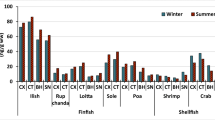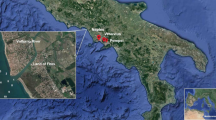Abstract
Indicator polychlorinated biphenyls (PCBs) and organochlorine pesticides (OCPs) were determined in 289 seafood samples including fishes, crustaceans, and shellfish collected from six administrative regions in Xiamen of China. The residual levels of PCBs, dichlorodiphenyltrichloroethane and its metabolites (DDTs), and hexachlorocyclohexanes (HCHs) ranged <LOD–64 (median 1.8) ng g−1 wet weight (ww), 0.03–88 (median 1.4) ng g−1 ww, and <LOD–5.5 (median <LOD) ng g−1 ww, respectively. The most abundant compounds were PCB101, p,p′-DDT, and β-HCH. Significant differences in the amounts of PCBs and DDTs were recorded among the species, whereas no significant differences were observed among the species with regard to HCH concentrations. Within the regions investigated, the concentrations of PCBs were much lower in Haicang than in other regions and HCHs were detected with highest concentration in Siming, while no significant differences were observed in DDT concentrations. Principal component analysis (PCA) showed that PCB and OCP pollutions came from similar sources in Xiamen. But the pollution sources of Xiangan were diverse. The predominance of PCBs might be attributed to the past usage of domestically produced commercial PCB mixtures, and the profiles of OCPs might indicate their current use in agriculture. Results of carcinogenic risk assessment based on the 50th or 95th percentile exposure levels exceeded the threshold, suggesting that the PCBs should be of concern. On the other hand, the hazard quotients (HQs) of noncancer risks were all far below than 1.






Similar content being viewed by others
References
Arnich N, Tard A, Leblanc JC, Bizec BL, Narbonne JF, Maximilien R (2009) Dietary intake of non-dioxin-like PCBs (NDL-PCBs) in France, impact of maximum levels in some foodstuffs. Regul Toxicol Pharmacol 54(3):287–293
Baars AJ, Bakker MI, Baumann RA, Boon PE, Freijer JI, Hoogenboom LAP et al (2004) Dioxins, dioxin-like PCBs and non-dioxin-like PCBs in foodstuffs: occurrence and dietary intake in the Netherlands. Toxicol Lett 151(1):51–61
Barone G, Giacominelli-Stuffler R, Garofalo R, Castiglia D, Storelli MM (2014) PCBs and PCDD/PCDFs in fishery products: occurrence, congener profile and compliance with European Union legislation. Food Chem Toxicol 74:200–205
Berntssen MHG, Maage A, Julshamn K, Oeye BE, Lundebye A-K (2011) Carry-over of dietary organochlorine pesticides, PCDD/fs, PCBs, and brominated flame retardants to Atlantic salmon (Salmo salar L.) fillets. Chemosphere 83(2):95–103
Chen WQ, Zhang LP, Xu L, Wang XH, Hong LY, Hong HH (2002) Residue levels of HCHs, DDTs and PCBs in shellfish from coastal areas of East Xiamen Island and Minjiang estuary China. Mar Pollut Bull 45:385–390
Chen C, Qian YZ, Chen Q, Li CY (2011) Assessment of daily intake of toxic elements due to consumption of vegetables, fruits, meat, and seafood by inhabitants of Xiamen, China. J Food Sci 76(8):T181–T188
De la Cala A, Eljarrat E, Ralduáb D, Duránc C, Barcelóa D (2008) Spatial variation of DDT and its metabolites in fish and sediment from Cinca River, a tributary of Ebro River (Spain). Chemosphere 70(7):1182–1189
Dickman MD, Leung KMC (1998) Mercury and organochlorine exposure from fish consumption in Hong Kong. Chemosphere 37(5):991–1015
EC (European Commission) (2000) Assessment of dietary intake of dioxins and related PCBs by the population of EU Member States http://ec.europa.eu/dgs/health_consumer/library/pub/pub08_en.pdf. Accessed April, 2015
EC (European Commission) No 1881/2006 (2006) Setting maximum levels for certain contaminants in foodstuffs. http://eur-lex.europa.eu/eli/reg/2006/1881/oj#ntr31-L_2006364EN.01001501-E0031.Accessed November, 2016
ESFA (European Food and Safety Authority) (2010) Results of the monitoring of non dioxin-like PCBs in food and feed. ESFA J. vol.8, p. 35
Freitag A, Sohn N, Hooper M, Rittschof D (2012) The geography of mercury and PCBs in North Carolina’s local seafood. Mar Pollut Bull 64:1330–1338
Guo JY, Zeng EY, Wu FC, Meng XZ, Mai BX, Luo XJ (2007) Organochlorine pesticides in seafood products from southern China and health risk assessment. Environ Toxicol Chem 26(6):1109–1115
Herceg-Romanića S, Kljaković-Gašpića Z, Klinčića D, Ujević I (2014) Distribution of persistent organic pollutants (POPs) in cultured mussels from the Croatian coast of the Adriatic Sea. Chemosphere 114:69–75
Hitch RK, Day HR (1992) Unusual persistence of DDT in some western USA soils. Bull Environ ContamToxicol 48(2):259–264
James D (2013) Risks and benefits of seafood consumption. GLOBEFISH Research Programme, FAO, Rome, Italy
Lavandier R, Quinete N, Hauser-Davis RA, Dias PS, Taniguchi S, Montone R, Moreira I (2013) Polychlorinated biphenyls (PCBs) and polybrominated diphenyl ethers (PBDEs) in three fish species from an estuary in the southeastern coast of Brazil. Chemosphere 90(9):2435–2443
Li J, Huang ZY, Hu Y, Yang H (2013) Potential risk assessment of heavy metals by consuming shellfish collected from Xiamen. China Environ Sci Pollut Res 20(5):2937–2947
Liu Z, Zhang HM, Tao MH, Yang SB, Wang LW, Liu Y et al (2010) Organochlorine pesticides in consumer fish and mollusks of Liaoning Province, China: distribution and human exposure implications. Arch Environ Contam Toxicol 59(3):444–453
Liu YP, Li JG, Zhao YF, Wen S, Huang FF, Wu YN (2011) Polybrominated diphenyl ethers (PBDEs) and indicator polychlorinated biphenyls (PCBs) in marine fish from four areas of China. Chemosphere 83(2):168–174
Mihats D, Mocheb W, Preanc M, Rauscher-Gabernig E (2015) Dietary exposure to non-dioxin-like PCBs of different population groups in Austria. Chemosphere 126:53–59
Nakata H, Kawazoe M, Arizono K, Abe S, Kitano T, Shimada H et al (2002) Organochlorine pesticides and polychlorinated biphenyl residues in foodstuffs and human tissues from China: status of contamination, historical trend, and human dietary exposure. Arch Environ Contam Toxicol 43(4):473–480
National Physique Monitoring Center of China (2010) Bulletin of China’s national physical fitness monitoring in 2010. http://www.sport.gov.cn/n16/n1077/n1467/n2056653/2056849.html. Accessed April, 2015
Shen HT, Yu C, Ying Y, Zhao YF, Wu YN, Han JL, Xu QY (2009) Levels and congener profiles of PCDD/fs, PCBs and PBDEs in seafood from China. Chemosphere 77(9):1206–1211
Smith AG, Gangolli SD (2002) Organochlorine chemicals in seafood: occurrence and health concerns. Food Chem Toxicol 40(6):767–779
Storellia MM, Baronea G, Perronea VG, Giacominelli-Stufflerb R (2011) Polychlorinated biphenyls (PCBs), dioxins and furans (PCDD/fs): occurrence in fishery products and dietary intake. Food Chem 127(4):1648–1652
Thomas M, Lazartigues A, Damien B, Brun-Bellut J, Feidt C (2012) Organochlorine pesticides and polychlorinated biphenyls in sediments and fish from fresh water cultured fish ponds in different agricultural contexts in north-eastern France. Ecotox Environ Safe 77:35–44
UNEP (United Nations Environmental Protection) (2001) Final Act of the Conference of Plenipotentiaries on the Stockholm Convention on Persistent Organic Pollutants, Stockholm, Sweden
USEPA (United States Environmental Protection Agency) (2000) Guidance for assessing chemical contaminant data for use in fish advisories, volume 2: risk assessment and fish consumption limits, third ed http://water.epa.gov/scitech/swguidance/fishshellfish/techguidance/risk/upload/2009_04_23_fish_advice_volume2_v2cover.pdf. Accessed April, 2015.
USEPA (United States Environmental Protection Agency) (2005) Guidelines for carcinogen risk assessment http://www2.epa.gov/sites/production/files/2013-09/documents/cancer_guidelines_final_3-25-05.pdf. Accessed April, 2015
Wang HS, ZhaoYG MYB, CKC W, Wong MH (2011) Oral bioaccessibility and human risk assessment of organochlorine pesticides (OCPs) via fish consumption, using an in vitro gastrointestinal model. Food Chem 127(4):1673–1679
WHO (World Health Organization) (2009) Inventory of IPCS and other WHO pesticide evaluations and summary of toxicological evaluations performed by the Joint Meeting on Pesticide Residues (JMPRs) through 2009 http://www.who.int/ipcs/publications/jmpr/pesticide_inventory_edition10.pdf. Accessed April, 2015
Wong MH, Leung AOW, Chan JKY, Choi MPK (2005) A review on the usage of POP pesticides in China, with emphasis on DDT loadings in human milk. Chemosphere 60(6):740–752
Xia CH, Lam JCW, Wu XG, Xie ZQ, Lam PKS (2012) Polychlorinated biphenyls (PCBs) in marine fishes from China: levels, distribution and risk assessment. Chemosphere 89(8):944–949
Xiamen Municipal Bureau of Statistics (2011) Main data bulletin of the Xiamen sixth national population census in 2010. http://www.stats-xm.gov.cn/tjzl/tjgb/zxgb/201106/t20110610_18534.htm. Accessed April, 2015
Yang RQ, Lv AH, Shi JB, Jaing GB (2005) The level and distribution of organochlorine pesticides (OCPs) in sediments from the Haihe River. China Chemosphere 61(3):347–354
Yang RQ, Wang YW, Li A, Zhang QH, Jing CY, Wang T et al (2010) Organochlorine pesticides and PCBs in fish from lakes of the Tibetan Plateau and the implications. Environ Pollut 158(6):2310–2316
Yu HY, Bao LJ, Liang Y, Zeng EY (2011) Field validation of anaerobic degradation pathways for dichlorodiphenyltrichloroethane (DDT) and 13 metabolites in marine sediment cores from China. Environ Sci Technol 45(12):5245–5252
Zhang ZL, Hong HS, Zhou JL, Huang J, Yu G (2003) Fate and assessment of persistent organic pollutants in water and sediment from Minjiang River estuary. Southern China Chemosphere 52(9):1423–1430
Zhang J, Liu F, Chen RB, Feng T, Dong SJ, Shen HQ (2012) Levels of polychlorinated biphenyls and organochlorine pesticides in edible shellfish from Xiamen (China) and estimation of human dietary intake. Food Chem Toxicol 50(12):4285–4291
Zhang L, Li JG, Zhao YF, Li XW, Wen S, Shen HT et al (2013) Polybrominated diphenyl ethers (PBDEs) and indicator polychlorinated biphenyls (PCBs) in foods from China: levels, dietary intake, and risk assessment. J Agric Food Chem 61(26):6544–6551
Acknowledgements
We are grateful to the financial support of the Ocean Public Welfare Scientific Research Project of State Oceanic Administration of China (Nos. 201305043-4, 201505034-4), Fujian Province Regional Demonstration Project of Marine Economic Innovation and Development (2014FJPT01), Xiamen South Ocean Research Center Project (14PZY017NF17), and the Fujian Provincial Project in Developments of High Technological and New Industries for Marines ([2014] No. 18).
Author information
Authors and Affiliations
Corresponding author
Ethics declarations
Conflict of interest
The authors declare that they have no conflict of interest.
Additional information
Responsible editor: Ester Heath
Rights and permissions
About this article
Cite this article
Qian, Z., Luo, F., Wu, C. et al. Indicator polychlorinated biphenyls (PCBs) and organochlorine pesticides (OCPs) in seafood from Xiamen (China): levels, distributions, and risk assessment. Environ Sci Pollut Res 24, 10443–10453 (2017). https://doi.org/10.1007/s11356-017-8659-4
Received:
Accepted:
Published:
Issue Date:
DOI: https://doi.org/10.1007/s11356-017-8659-4




